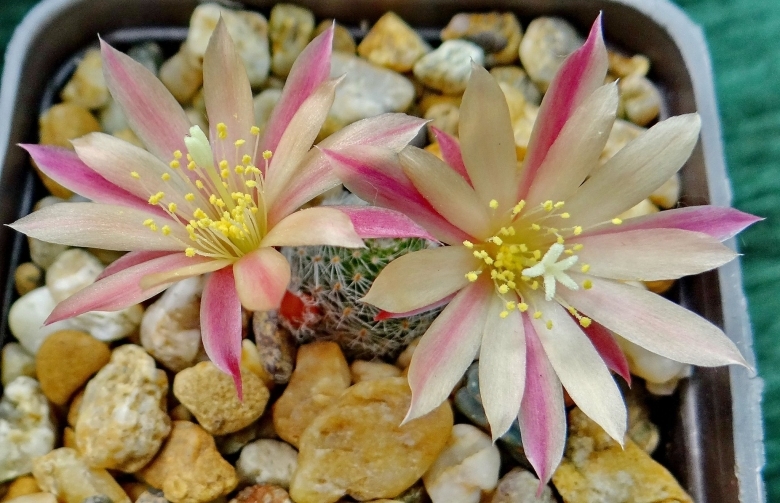Accepted Scientific Name: Rebutia cv. sunrise

Rebutia heliosa cv. sunrise (Rebutia cv. sunrise) Photo by: Agócs György
Origin and Habitat: Garden origin, hybrid.
Synonyms:
See all synonyms of Rebutia sunrise
Description: Rebutia cv. sunriseSN|5031]]SN|30873]] is a popular variety obtained by hybridization, specifically between Rebutia heliosaSN|5204]]SN|5204]] and Rebutia pulvinosaSN|30873]]SN|5031]] ssp. albiflora (syn: Aylostera albifloraSN|4931]]SN|4931]]). This cross resulted in a plant more vigorous than their parents, with stem tightly covered by appressed spines reminding of R. heliosa and lovely fresh pinky white flowers in masse that clearly are a feature inherited from R. pulvinosa ssp. albiflora. This is a really nice cultivar which is just stunning each year, a must for any collection.
Stems: Fattened, globular, light-green, up to 3 cm diameter and branching profusely from near the base.
Flowers: Funnel shaped ca. 3 cm in diameter often larger than the stems. Petals pink outside, pale yellow-orange inside (although at first glance they give the impression of having a creamy hue), so throughout the day, depending on the degree of opening of the flowers, the petals change the colour we perceive according to the intensity of light they receive. Flowers emerge from the base of the plant between the parent and offspring, resulting in a superb display in mid season.
 Rebutia heliosa cv. sunrise (Rebutia cv. sunrise) Photo by: Carolina González
Rebutia heliosa cv. sunrise (Rebutia cv. sunrise) Photo by: Carolina González Rebutia heliosa cv. sunrise (Rebutia cv. sunrise) Photo by: Xero Sicyos
Rebutia heliosa cv. sunrise (Rebutia cv. sunrise) Photo by: Xero Sicyos Rebutia heliosa cv. sunrise (Rebutia cv. sunrise) Photo by: Peiffer Clement
Rebutia heliosa cv. sunrise (Rebutia cv. sunrise) Photo by: Peiffer Clement Rebutia heliosa cv. sunrise (Rebutia cv. sunrise) Photo by: Diego Armentano
Rebutia heliosa cv. sunrise (Rebutia cv. sunrise) Photo by: Diego Armentano Rebutia heliosa cv. sunrise (Rebutia cv. sunrise) Photo by: Diego Armentano
Rebutia heliosa cv. sunrise (Rebutia cv. sunrise) Photo by: Diego Armentano Rebutia heliosa cv. sunrise (Rebutia cv. sunrise) Photo by: Carolina González
Rebutia heliosa cv. sunrise (Rebutia cv. sunrise) Photo by: Carolina González Rebutia heliosa cv. sunrise (Rebutia cv. sunrise) Photo by: Carolina González
Rebutia heliosa cv. sunrise (Rebutia cv. sunrise) Photo by: Carolina González Rebutia heliosa cv. sunrise (Rebutia cv. sunrise) Photo by: Carolina González
Rebutia heliosa cv. sunrise (Rebutia cv. sunrise) Photo by: Carolina GonzálezCultivation and Propagation: Rebutia cv. sunriseSN|30873]]SN|30873]] is a summer grower plant that is easy to cultivate.
Growth rate: It is a relatively rapidly growing and easily flowering species that will make large clumps given the best conditions.
Soils: It likes very porous standard cactus mix soil. Prefer a neutral or low pH compost, avoid substrata rich in limestone.
Repotting: It is better that they are repotted regularly. Repotting will increase the number and size of stems and will increase the number of flowers produced. Repot yearly until reaching about 100 mm in size, then every two or three years will suffice. Repotting is best done at the end of winter but can be done at other times. Do not water for a couple of weeks after repotting to reduce risk of root rot via broken roots. Use pot with good drainage.
Watering: Needs moderate to copious waterings in summer, but do not overwater (Rot prone), keep dry in winter at a minimum temperature of 0°C.
Fertilization: Feed with a high potassium fertilizer in summer.
Hardiness: Reputedly resistant to frost if kept on the dry side prior to, and during, cold weather (hardy to -4 C ° C, or less for short periods).
Exposition: The plant tolerates bright situations but enjoys filtered sunlight or afternoon shade, inside it needs bright light, and some direct sun. Tends to bronze in strong light, which encourages flowering and heavy spine production, but is likely to suffer from sun scorch or stunted growth if over exposed to direct sunlight during the hottest part of the day in summer.
Uses: It is an excellent plant for container growing. It always looks good and stays small. It look fine in a cold greenhouse and frame or outdoor in a rockery.
Pests & diseases: It may be attractive to a variety of insects, but plants in good condition should be nearly pest-free, particularly if they are grown in a mineral potting-mix, with good exposure and ventilation. Nonetheless, there are several pests to watch for:
- Red spiders: Red spiders may be effectively rubbed up by watering the plants from above.
- Mealy bugs: Mealy bugs occasionally develop aerial into the new growth among the wool with disfiguring results, but the worst types develop underground on the roots and are invisible except by their effects.
- Scales: Scales are rarely a problem.
- Rot: This species is particularly easy and accommodating, seldom suffer of cryptogamic diseases. Rot it is only a minor problem with rebutias if the plants are watered and “aired” correctly. If they are not, fungicides won't help all that much.
Propagation: Division. To make a cutting twist off a branch and permit it to dry out a couple of weeks, lay it on the soil and insert the stem end partially into the soil. Try to keep the cutting somewhat upright so that the roots are able to grow downward.


















